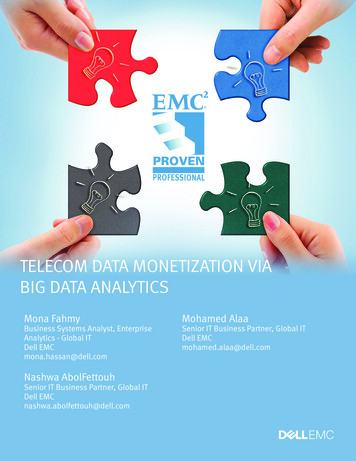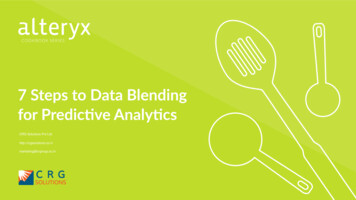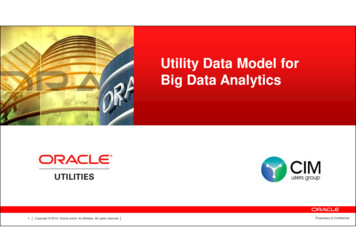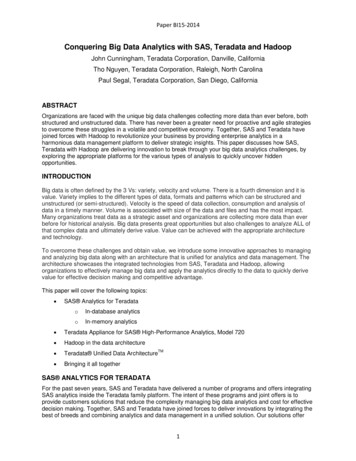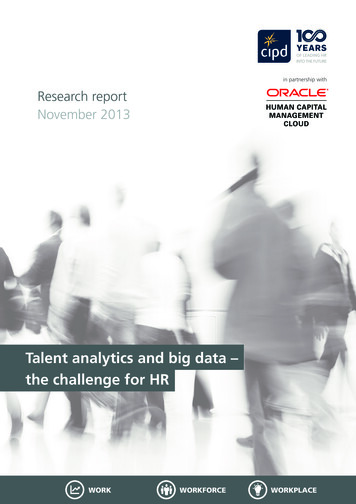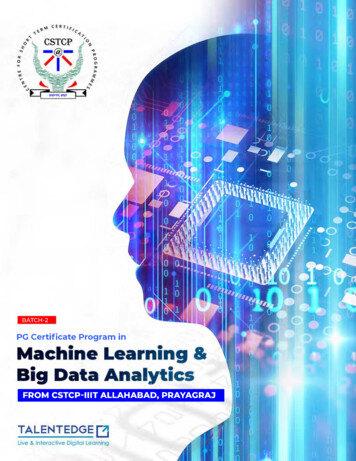
Transcription
Technological Forecasting & Social Change 126 (2018) 3–13Contents lists available at ScienceDirectTechnological Forecasting & Social ChangeBig data analytics: Understanding its capabilities and potential benefitsfor healthcare organizationsYichuan Wang a,⁎, LeeAnn Kung b, Terry Anthony Byrd aabRaymond J. Harbert College of Business, Auburn University, 405 W. Magnolia Ave., Auburn, AL 36849, USARohrer College of Business, Rowan University, 201 Mullica Hill Road, Glassboro, NJ 08028, USAa r t i c l ei n f oArticle history:Received 17 June 2015Received in revised form 11 November 2015Accepted 12 December 2015Available online 26 February 2016Keywords:Big data analyticsBig data analytics architectureBig data analytics capabilitiesBusiness value of information technology (IT)Health carea b s t r a c tTo date, health care industry has not fully grasped the potential benefits to be gained from big data analytics.While the constantly growing body of academic research on big data analytics is mostly technology oriented, abetter understanding of the strategic implications of big data is urgently needed. To address this lack, thisstudy examines the historical development, architectural design and component functionalities of big data analytics. From content analysis of 26 big data implementation cases in healthcare, we were able to identify five bigdata analytics capabilities: analytical capability for patterns of care, unstructured data analytical capability, decision support capability, predictive capability, and traceability. We also mapped the benefits driven by big data analytics in terms of information technology (IT) infrastructure, operational, organizational, managerial andstrategic areas. In addition, we recommend five strategies for healthcare organizations that are considering toadopt big data analytics technologies. Our findings will help healthcare organizations understand the big data analytics capabilities and potential benefits and support them seeking to formulate more effective data-driven analytics strategies. 2016 Elsevier Inc. All rights reserved.1. IntroductionInformation technology (IT)-related challenges such as inadequateintegration of healthcare systems and poor healthcare informationmanagement are seriously hampering efforts to transform IT value tobusiness value in the U.S. healthcare sector (Bodenheimer, 2005;Grantmakers In Health, 2012; Herrick et al., 2010; The Kaiser FamilyFoundation, 2012). The high volume digital flood of information thatis being generated at ever-higher velocities and varieties in healthcareadds complexity to the equation. The consequences are unnecessary increases in medical costs and time for both patients and healthcare service providers. Thus, healthcare organizations are seeking effective ITartifacts that will enable them to consolidate organizational resourcesto deliver a high quality patient experience, improve organizational performance, and maybe even create new, more effective data-driven business models (Agarwal et al., 2010; Goh et al., 2011; Ker et al., 2014).One promising breakthrough is the application of big data analytics.Big data analytics that is evolved from business intelligence and decisionsupport systems enable healthcare organizations to analyze an immense volume, variety and velocity of data across a wide range ofhealthcare networks to support evidence-based decision making andaction taking (Watson, 2014; Raghupathi and Raghupathi, 2014). Big⁎ Corresponding author.E-mail addresses: yzw0037@auburn.edu (Y. Wang), kung@rowan.edu (L. Kung),byrdter@auburn.edu (T.A. .0190040-1625/ 2016 Elsevier Inc. All rights reserved.data analytics encompasses the various analytical techniques such asdescriptive analytics and mining/predictive analytics that are ideal foranalyzing a large proportion of text-based health documents andother unstructured clinical data (e.g., physician's written notes and prescriptions and medical imaging) (Groves et al., 2013). New databasemanagement systems such as MongoDB, MarkLogic and ApacheCassandra for data integration and retrieval, allow data being transferred between traditional and new operating systems. To store thehuge volume and various formats of data, there are Apache HBase andNoSQL systems. These big data analytics tools with sophisticated functionalities facilitate clinical information integration and provide freshbusiness insights to help healthcare organizations meet patients'needs and future market trends, and thus improve quality of care and financial performance (Jiang et al., 2014; Murdoch and Detsky, 2013;Wang et al., 2015).A technological understanding of big data analytics has been studiedwell by computer scientists (see a systemic review of big data researchfrom Wamba et al., 2015). Yet, healthcare organizations continue tostruggle to gain the benefits from their investments on big data analytics and some of them are skeptical about its power, although they investin big data analytics in hope for healthcare transformation (Murdochand Detsky, 2013; Shah and Pathak, 2014). Evidence shows that only42% of healthcare organizations surveyed are adopting rigorous analytics approaches to support their decision-making process; only 16% ofthem have substantial experience using analytics across a broad rangeof functions (Cortada et al., 2012). This implies that healthcare
4Y. Wang et al. / Technological Forecasting & Social Change 126 (2018) 3–13practitioners still vaguely understand how big data analytics can createvalue for their organizations (Sharma et al., 2014). As such, there is anurgent need to understand the managerial, economic, and strategic impact of big data analytics and explore its potential benefits driven by bigdata analytics. This will enable healthcare practitioners to fully seize thepower of big data analytics.To this end, two main goals of this study are: first, to identify big dataanalytics capabilities; and second, to explore the potential benefits itmay bring. By doing so, we hope to give healthcare organization amore current comprehensive understanding of big data analytics andhow it helps to transform organizations. In this paper, we begin by providing the historical context and developing big data analytics architecture in healthcare, and then move on to conceptualizing big dataanalytics capabilities and potential benefits in healthcare. We conducted a content analysis of 26 big data implementation cases in healthcare which lead to the identification of five major big data analytics capabilities and potential benefits derived from its application. In concluding sections, we present several strategies for being successful with bigdata analytics in healthcare settings as well as the limitations of thisstudy, and direction of future research.predictive modeling and simulation techniques for analyzing healthcaredata as a whole have not yet been adequately developed.More recent trend of big data analytics technology has been towardsthe use of cloud in conjunction with data. Enterprises have increasinglyadopted a “big data in the cloud” solution such as software-as-a-service(SaaS) that offers an attractive alternative with lower cost. According tothe Gartner's, 2013 IT trend prediction, taking advantage of cloud computing services for big data analytics systems that support a real-timeanalytic capability and cost-effective storage will become a preferredIT solution by 2016. The main trend in the healthcare industry is ashift in data type from structure-based to semi-structured based(e.g., home monitoring, telehealth, sensor-based wireless devices) andunstructured data (e.g., transcribed notes, images, and video). The increasing use of sensors and remote monitors is a key factor supportingthe rise of home healthcare services, meaning that the amount of databeing generated from sensors will continue to grow significantly. Thiswill in turn improve the quality of healthcare services through more accurate analysis and prediction.2. BackgroundTo reach our goals of this study which are to describe the big data analytics capability profile and its potential benefits, it is necessary to understand its architecture, components and functionalities. The firstaction taken is to explore best practice of big data analytics architecturein healthcare. We invited four IT experts (two practitioners and two academics) to participate in a five-round evaluation process which included brainstorming and discussions. The resulted big data analyticsarchitecture is rooted in the concept of data life cycle framework thatstarts with data capture, proceeds via data transformation, and culminates with data consumption. Fig. 1 depicts the proposed best practicebig data analytics architecture that is loosely comprised of five major architectural layers: (1) data, (2) data aggregation, (3) analytics, (4) information exploration, and (5) data governance. These logical layers makeup the big data analytics components that perform specific functions,and will therefore enable healthcare managers to understand how totransform the healthcare data from various sources into meaningfulclinical information through big data implementations.2.1. Big data analytics: past and presentThe history of big data analytics is inextricably linked with that ofdata science. The term “big data” was used for the first time in 1997by Michael Cox and David Ellsworth in a paper presented at an IEEE conference to explain the visualization of data and the challenges it posedfor computer systems (Cox and Ellsworth, 1997). By the end of the1990s, the rapid IT innovations and technology improvements had enabled generation of large amount of data but little useable informationin comparison. Concepts of business intelligence (BI) created to emphasize the importance of collection, integration, analysis, and interpretation of business information and how this set of process can helpbusinesses make more appropriate decisions and obtain a better understanding of market behaviors and trends.The period of 2001 to 2008 was the evolutionary stage for big datadevelopment. Big data was first defined in terms of its volume, velocity, and variety (3Vs), after which it became possible to developmore sophisticated software to fulfill the needs of handling information explosion accordingly. Software and application developmentslike Extensible Markup Language (XML) Web services, databasemanagement systems, and Hadoop added analytics modules andfunctions to core modules that focused on enhancing usability forend users, and enabled users to process huge amounts of data acrossand within organizations collaboratively and in real-time. At thesame time, healthcare organizations were starting to digitize theirmedical records and aggregate clinical data in huge electronic databases. This development made the health data storable, usable,searchable, and actionable, and helped healthcare providers practicemore effective medicine.At the beginning of 2009, big data analytics entered the revolutionary stage (Bryant et al., 2008). Not only had big-data computing becomea breakthrough innovation for business intelligence, but also researchers were predicting that data management and its techniqueswere about to shift from structured data into unstructured data, andfrom a static terminal environment to a ubiquitous cloud-based environment. Big data analytics computing pioneer industries such asbanks and e-commerce were beginning to have an impact on improvingbusiness processes and workforce effectiveness, reducing enterprisecosts and attracting new customers. In regards to healthcare industry,as of 2011, stored health care data had reached 150 exabytes (1 EB 1018 bytes) worldwide, mainly in the form of electronic health records(Institute for Health Technology Transformation, 2013). However,most of the potential value creation is still in its infancy, because2.2. Big data analytics architecture2.2.1. Data layerThis layer includes all the data sources necessary to provide theinsights required to support daily operations and solve businessproblems. Data is divided into structured data such as traditionalelectronic healthcare records (EHRs), semi-structured data such asthe logs of health monitoring devices, and unstructured data suchas clinical images. These clinical data are collected from various internal or external locations, and will be stored immediately into appropriate databases, depending on the content format.2.2.2. Data aggregation layerThis layer is responsible for handling data from the various datasources. In this layer, data will be intelligently digested by performingthree steps: data acquisition, transformation, and storage. The primarygoal of data acquisition is to read data provided from various communication channels, frequencies, sizes, and formats. This step is often amajor obstacle in the early stages of implementing big data analytics,because these incoming data characteristics might vary considerably.Here, the cost may well exceed the budget available for establishingnew data warehouses, and extending their capacity to avoid workloadbottlenecks. During the transformation step, the transformation enginemust be capable of moving, cleaning, splitting, translating, merging,sorting, and validating data. For example, structured data such as thattypically contained in an eclectic medical record might be extractedfrom healthcare information systems and subsequently converted intoa specific standard data format, sorted by the specified criterion(e.g., patient name, location, or medical history), and then the record
Y. Wang et al. / Technological Forecasting & Social Change 126 (2018) 3–135Fig. 1. Big data analytics architecture in health care.validated against data quality rules. Finally, the data are loaded into thetarget databases such as Hadoop distributed file systems (HDFS) or in aHadoop cloud for further processing and analysis. The data storage principles are based on comp
ing sections, we present several strategies for being successful with big data analytics in healthcare settings as well as the limitations of this study, and direction of future research. 2. Background 2.1. Big data analytics: past and present The history of big data analytics is inextricably linked with that of data science. The term “big data” was used for the first time in 1997File Size: 715KBPage Count: 11



